Separatism

This article has multiple issues. Please help improve it or discuss these issues on the talk page. (Learn how and when to remove these messages)
|
| Part of the Politics series |
| Politics |
|---|
|
|
Separatism is the advocacy of cultural, ethnic, tribal, religious, racial, regional, governmental, or gender separation from the larger group. As with secession, separatism conventionally refers to full political separation. Groups simply seeking greater autonomy are usually not considered separatists.[1] Some discourse settings equate separatism with religious segregation, racial segregation, or sex segregation, while other discourse settings take the broader view that separation by choice may serve useful purposes and is not the same as government-enforced segregation. There is some academic debate about this definition, and in particular how it relates to secessionism, as has been discussed online.[2]
Separatist groups practice a form of identity politics, or political activity and theorizing founded in the shared experiences of the group's members. Such groups believe attempts at integration with dominant groups compromise their identity and ability to pursue greater self-determination.[3] However, economic and political factors usually are critical in creating strong separatist movements as opposed to less ambitious identity movements.[4]
Motivations
[edit]
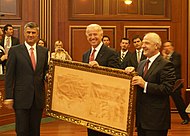
Groups may have one or more motivations for separation, including:[5]
- Emotional resentment and hatred of rival communities.
- Protection from genocide and ethnic cleansing.
- Resistance by victims of oppression, including denigration of their language, culture or religion.
- Influence and propaganda by those inside and outside the region who hope to gain politically from intergroup conflict and hatred.
- Economic and political dominance of one group that does not share power and privilege in an egalitarian fashion.
- Economic motivations: seeking to end economic exploitation by more powerful group or, conversely, to escape economic redistribution from a richer to a poorer group.
- Preservation of threatened religious, language or other cultural tradition.
- Destabilization from one separatist movement giving rise to others.
- Geopolitical power vacuum from breakup of larger states or empires.
- Continuing fragmentation as more and more states break up.
- Feeling that the perceived nation was added to the larger state by illegitimate means.
- The perception that the state can no longer support one's own group or has betrayed their interests.
- Opposition to political decisions.
Types
[edit]Ethnic separatism can be based on cultural, linguistic as well as religious or racial differences. Ethnic separatist movements were relevant since they represented historical delineations between states, or in recent times, were the cause of conflicts between peoples in Europe, Africa and Asia with different ethnic/linguistic origins.
Separatism by continent
[edit]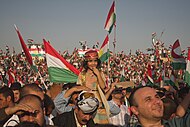

- List of active separatist movements in Africa
- List of active separatist movements in Asia
- List of active separatist movements in Europe
- List of active separatist movements in North America
- List of active separatist movements in Oceania
- List of active separatist movements in South America
Gender separatism
[edit]The relationship between gender and separatism is complex.[6] Feminist separatism is women's choosing to separate from ostensibly male-defined, male-dominated institutions, relationships, roles and activities.[7] Lesbian separatism advocates lesbianism as the logical result of feminism. Some separatist feminists and lesbian separatists have chosen to live apart in intentional community, cooperatives, and on land trusts.[8] Queer nationalism (or "Gay separatism") seeks a community distinct and separate from other social groups.[9][10] On the other hand, the MGTOW movement is sometimes considered a male-gender separatism, as at the center of this ideology is the notion of male separatism where men should not be a part of a feminist-biased society. Some fringe elements even propose a utopical no-women state.[11][12][13]
Geographical and socioeconomic separatism
[edit]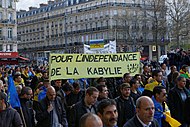

Some examples include:
- Alberta separatism
- Berber separatism in North Africa
- Bougainville independence movement
- Cape Independence
- Casamance independence movement
- Cascadian separatists
- Catalan independence movement
- Provisional Revolutionary Government of Cibao
- Euskadi (Basque Country) independence movement
- Hong Kong independence movement
- New England New State Movement
- Malaysian Sabah and Sarawak separatists
- West Papuan independence
- Free South movement
- Quebec sovereignty movement
- Scottish independence movement
- Taiwanese independence movement
Racial separatism
[edit]The examples and perspective in this section deal primarily with the United States and do not represent a worldwide view of the subject. (August 2011) |
Some separatist groups seek to separate from others along racial lines. They oppose interracial marriage and integration with other races and seek separate schools, businesses, churches and other institutions, and often separate societies, territories, countries, and governments:
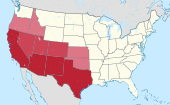
- Black separatism (also known as black nationalism) is the most prominent wave advancing the concepts of "Black racial identity" in the United States and has been advanced by black leaders like Marcus Garvey and organizations such as the Nation of Islam. Critical race theorists like New York University's Derrick Bell and University of Colorado's Richard Delgado argue that US legal, education and political systems are rife with blatant racism. They support efforts like "all-black" schools and dorms and question the efficacy and merit of government-enforced integration.[14] In 2008 statements by Barack Obama's former pastor Jeremiah Wright, Jr., revived the issue of the current relevance of black separatism.[15]
- Latin American concepts of racial identity such as the bronze race and La Raza Cósmica are found in the small separatist Raza Unida Party. The Chicano Movement (or Chicano nation) in the United States sought to recreate Aztlán, the mythical homeland of the Aztecs comprising the Southwestern United States.[16]
- White separatism in the United States and Western Europe seeks separation of the white race and limits to nonwhite immigration under the argument that these policies are necessary for the white race's survival.
Religious separatism
[edit]This section possibly contains original research. (November 2015) |
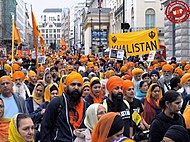
Religious separatist groups and sects want to withdraw from some larger religious groups and/or believe they should interact primarily with coreligionists:[citation needed]
- English Christians in the 16th and 17th centuries who wished to separate from the Church of England and form independent local churches were influential politically under Oliver Cromwell, who was himself a separatist. They were eventually called Congregationalists.[17] The Pilgrims who established the first successful colony in New England were separatists.[18]
- Christian separatist groups in Indonesia,[19][20] India[21] and South Carolina (United States)[22][23]
- Zionism sought the creation of the State of Israel as a Jewish homeland, with separation from gentile Palestinians. Simon Dubnow, who had mixed feelings toward Zionism, formulated Jewish Autonomism, which was adopted in eastern Europe by Jewish political parties such as the Bund and his own Folkspartei before World War II.[24] Zionism can also be seen as somewhat ethnic too, however, as its definition of who is Jewish has often included people of Jewish background who do not practice the Jewish religion. It is further complicated as some who had ancestors who converted to Judaism, such as some Ethiopian Jews, may not share ethnic history with the Jews, however, are considered to be so but not without debate.[25]

- The Partition of India and (later Pakistan and Bangladesh) arose as a result of separatism on the part of Muslims.
- Sikhs in India sought an independent nation of Khalistan after an agitation in the 1970s and 1980s for implementation of the Anandpur Sahib Resolution (demanding things such as a greater share of river water and autonomy for Punjab) resulted in the storming of the Harimandir Sahib (Golden Temple) by the Government of India troops in 1984. The storming of the temple to flush out Sikh Militants who were gaining momentum in their agitation for greater autonomy for Punjab resulted in Sikhs demanding an independent state for the Sikhs situated in Punjab known as Khalistan. The conflict escalated and led to an assassination of the Prime Minister of India Indira Gandhi as a retaliation of an Indian military operation called 'Operation Blue Star' directed against the Sikhs' holiest shrine, the Golden Temple, in which many innocent Sikh civilians too died. The revenge murder of Gandhi evoked a Congress Party led backlash in the form of the Sikh genocide, which started in New Delhi and swept India in November 1984. That only further strengthened the Khalistan Movement, but it was largely subdued owing to the efforts of the police in Punjab. The controversial response by the Punjab State reportedly involved the use of human rights violations in the form of unexplained disappearances, faked encounters killings, rape and torture. However, many in the Sikh diaspora in the West and even Sikhs in India, still support the idea of Khalistan, but support has been dying since the 90's due to heavy Anti-Khalistan propaganda pushed by the Indian government, and fear of being targeted or killed for supporting Khalistan.[26]
- Muslim separatist groups in the Philippines (Mindanao and other regions: Moro Islamic Liberation Front, Abu Sayyaf), in Thailand (see also South Thailand insurgency), in India (see also Insurgency in Jammu and Kashmir), in the People's Republic of China (Xinjiang: East Turkestan Islamic Movement), Tanzania (Zanzibarian separatist movements), in the Central African Republic (Regions that are inhabited by Muslims: Séléka), in Russia (in the Northern Caucasus, especially in Chechnya: Caucasus Emirate), in Yugoslavia (Bosnia and Herzegovina: Alija Izetbegovic espoused an Islamic inspired separatism)
Governmental responses
[edit]
How far separatist demands will go toward full independence, and whether groups pursue constitutional and nonviolent action or armed violence, depend on a variety of economic, political, social and cultural factors, including movement leadership[27] and the government's response.[4] Governments may respond in a number of ways, some of which are mutually exclusive. Some include:[28]
- accede to separatist demands
- improve the circumstances of disadvantaged minorities, be they religious, linguistic, territorial, economic or political
- adopt "asymmetric federalism" where different states have different relations to the central government depending on separatist demands or considerations
- allow minorities to win in political disputes about which they feel strongly, through parliamentary voting, referendum, etc.
- settle for a confederation or a commonwealth relationship where there are only limited ties among states.
See also
[edit]Lists
[edit]General
[edit]- Annexation
- Autonomism (political doctrine)
- Ethnic nationalism
- Ethnic minority
- Ethnocentrism
- Homeland
- Identity politics
- Intersectionality
- Kinship
- Language secessionism
- Micronation
- Military occupation
- Multiculturalism
- Minority group
- Nation
- Polarization
- Partition
- Refugee
- Secession
- Stateless nation
- Unrepresented Nations and Peoples Organization
- Orania
- Volkstaat
References
[edit]- ^ Doyle, Don (2010). Secession as an International Phenomenon. University of Georgia Press. ISBN 9-780-8203-3008-2. Archived from the original on 2020-10-19. Retrieved 2020-10-16.
- ^ "Secessionism and Separatism Monthly Series: "Secession and Secessionism" by Alexandar Pavković - H-Nationalism - H-Net". networks.h-net.org. Archived from the original on 2016-04-01. Retrieved 2016-03-21.
- ^ "Identity Politics". Encyclopedia of Philosophy. Stanford University. November 2, 2007. Archived from the original on August 30, 2006. Retrieved May 7, 2008.
- ^ a b See D.L. Horowitz's "Patterns of Ethnic Separatism", originally published in Comparative Studies in Society and History, 1981, vol 23, 165-95. Republished in John A. Hall, The State: Critical Concepts, Archived 2017-03-27 at the Wayback Machine, Routledge, 1994.
- ^ Spencer, Metta (1998). Separatism: Democracy and Disintegration. Rowman & Littlefield. pp. 2–4. ISBN 9780847685851. Archived from the original on 2015-03-19. Retrieved 2015-08-15.
- ^ "Secessionism and Separatism Monthly Series: "Gendering Secession" by Jill Vickers - H-Nationalism - H-Net". networks.h-net.org. Archived from the original on 2018-09-13. Retrieved 2016-03-21.
- ^ Frye, Marilyn; Meyers, Diana Tietjens (1997). "Some Reflections on Separatism and Power". Feminist Social Thought: A Reader. Routledge. pp. 406–414.
- ^ Joyce Cheney, Lesbian Land, Word Weavers Press, 1976.
- ^ Mark K. Bloodsworth-Lugo, In-Between Bodies: Sexual Difference, Race, and Sexuality Archived 2017-03-27 at the Wayback Machine, SUNY Press, 2007, ISBN 0-7914-7221-3
- ^ Richard D. Mohr, Gays/Justice: A Study of Ethics, Society, and Law Archived 2019-06-19 at the Wayback Machine, Columbia University Press, 1988, ISBN 0-231-06735-6
- ^ Lamoureux, Mack (24 September 2015). "This Group of Straight Men Is Swearing Off Women". Vice. Retrieved 2022-06-04.
- ^ Bates, Laura (2020-08-26). "Men going their own way: the rise of a toxic male separatist movement". The Guardian. Retrieved 2022-06-04.
- ^ "Male supremacists have a new utopian dream". 7 February 2022. Retrieved 2022-06-04.
- ^ Foer, Franklin (November 23, 1997). "Racial Integration". Slate. Archived from the original on January 31, 2011. Retrieved May 7, 2008.
- ^ Barlow, Rich (April 26, 2008). "Topic turns to Wright case". Boston Globe.
- ^ Professor Predicts 'Hispanic Homeland' Archived 2012-11-07 at the Wayback Machine, Associated Press, 2000
- ^ "Encyclopædia Britannica on religious separatists". Archived from the original on 2008-10-12. Retrieved 2008-05-07.
- ^ Goodwin, John Abbot (1888). The Pilgrim republic: an historical review of the colony of New Plymouth. Houghton Mifflin Company. p. 1.
pilgrims.
- ^ "Christian separatist on trial in Indonesia". BBC. British Broadcasting Corporation. August 19, 2002. Archived from the original on November 4, 2018. Retrieved August 24, 2009.
- ^ Brummitt, Chris (April 5, 2002). "Christian separatist leader threatens to raise independence flags in Maluku". Associated Press. Archived from the original on February 15, 2011.
- ^ Hussain, Syed Zarir (December 31, 2002). "Christian separatist group in Tripura target tribal Hindus". Indo-Asian News Service. Archived from the original on November 4, 2018. Retrieved August 24, 2009.
- ^ "Christian separatist ready for new home". Ventura County Star. June 9, 2007. Archived from the original on August 6, 2012. Retrieved February 20, 2021.
- ^ "Colorado Rep. disavows ties to SC Christian separatist group". Associated Press. October 9, 2005. Archived from the original on September 13, 2018. Retrieved August 24, 2009.
- ^ Pinson, Koppel S. (1958). Simon Dubnow. pp. 13–69.
- ^ Lucotte G, Smets P; Smets (December 1999). "Origins of Falasha Jews studied by haplotypes of the Y chromosome". Human Biology. 71 (6): 989–993. PMID 10592688.
- ^ Punj, Blbir (June 16, 2006). "The Ghost of Khalistan". Sikh Times. Archived from the original on December 4, 2018. Retrieved July 5, 2008.
- ^ Link to: Archived 2008-06-11 at the Wayback Machine Chima, Jugdep. "Effects of Political Leadership on Ethnic Separatist Movements in India" Paper presented at the annual meeting of the Midwest Political Science Association, Palmer House Hotel, Chicago, Illinois, April 12, 2007, (PDF); Chima, Jugdep. "How Does Political Leadership Affect the Trajectories of Ethnic Separatist Insurgencies?: Comparative Evidence from Movements in India" Paper presented at the annual meeting of the American Political Science Association, Marriott Wardman Park, Omni Shoreham, Washington Hilton, Washington, DC, September 01, 2005 (PDF).
- ^ Metta Spencer, 5-6.
Further reading
[edit]- Kingsbury, Damien (March 2021). Separatism and the State. London: Routledge. ISBN 9780367276485.
- Brown, Graham K. "Horizontal Inequalities, Ethnic Separatism and Violent Conflict: The Case of Aceh, Indonesia" (PDF). United Nations Human Development Report 2005. Archived from the original (PDF) on 2008-05-12. Retrieved 2008-05-09.
- Griffiths, Ryan (March 26, 2008). "Globalization, Development and Separatism: The Influence of External and Internal Economic Factors on the Strategy of Separatism". Archived from the original on May 24, 2009.
Paper presented at the annual meeting of the ISA's 49th Annual Convention, Bridging Multiple Divides, Hilton San Francisco, San Francisco, California.
- Cabestan, Jean-Pierre; Pavković, Aleksandar, eds. (2013). Secessionism and Separatism in Europe and Asia: To have a state of one's own. Routledge. ISBN 978-0-415-66774-6.
- Cordesman, Anthony (October 9, 2007). "Pandora's Box: Iraqi Federalism, Separatism, "Hard" Partitioning, and US Policy" (PDF). Working Draft. Center for Strategic and International Studies. Archived from the original (PDF) on October 10, 2007.
- Millard, James (2004). "Violent Separatism in Xinjiang: A Critical Assessment" (PDF). eastwestcenter.org. Archived from the original (PDF) on 2012-02-22. Retrieved 2008-05-19.
- Miller, Michelle Ann (2004). "The Nanggroe Aceh Darussalam law: a serious response to Acehnese separatism?". Asian Ethnicity. pp. 333–351.
5(3)
- Miller, Michelle Ann (2012). Autonomy and Armed Separatism in South and Southeast Asia. Singapore: ISEAS.
- Keating, Joshua (2018). Invisible Countries: Journeys to the Edge of Nationhood. Yale. ISBN 978-0-300-22162-6.
External links
[edit] Media related to Separatism at Wikimedia Commons
Media related to Separatism at Wikimedia Commons- From Spain to Iraq, states have to see that suppressing secession won't work
